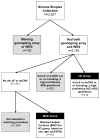Identification of Developmental and Behavioral Markers Associated With Genetic Abnormalities in Autism Spectrum Disorder
- PMID: 28253736
- PMCID: PMC5578709
- DOI: 10.1176/appi.ajp.2017.16101115
Identification of Developmental and Behavioral Markers Associated With Genetic Abnormalities in Autism Spectrum Disorder
Abstract
Objective: Aside from features associated with risk of neurogenetic syndromes in general (e.g., cognitive impairment), limited progress has been made in identifying phenotype-genotype relationships in autism spectrum disorder (ASD). The objective of this study was to extend work in the Simons Simplex Collection by comparing the phenotypic profiles of ASD probands with or without identified de novo loss of function mutations or copy number variants in high-confidence ASD-associated genes or loci.
Method: Analyses preemptively accounted for documented differences in sex and IQ in affected individuals with de novo mutations by matching probands with and without these genetic events on sex, IQ, and age before comparing them on multiple behavioral domains.
Results: Children with de novo mutations (N=112) had a greater likelihood of motor delay during early development (later age at walking), but they were less impaired on certain measures of ASD core symptoms (parent-rated social communication abnormalities and clinician-rated diagnostic certainty about ASD) in later childhood. These children also showed relative strengths in verbal and language abilities, including a smaller discrepancy between nonverbal and verbal IQ and a greater likelihood of having achieved fluent language (i.e., regular use of complex sentences).
Conclusions: Children with ASD with de novo mutations may exhibit a "muted" symptom profile with respect to social communication and language deficits relative to those with ASD with no identified genetic abnormalities. Such findings suggest that examining early milestone differences and standardized testing results may be helpful in etiologic efforts, and potentially in clinical differentiation of various subtypes of ASD, but only if developmental and demographic variables are properly accounted for first.
Keywords: Autism Spectrum Disorder; De Novo Mutations; Idiopathic ASD; Phenotype; Simons Simplex Collection; Syndromic ASD.
Figures



References
-
- Miles JH, Takahashi TN, Bagby S, Sahota PK, Vaslow DF, Wang CH, Hillman RE, Farmer JE. Essential versus complex autism: definition of fundamental prognostic subtypes. American journal of medical genetics Part A. 2005;135:171–180. - PubMed
-
- Tammimies K, Marshall CR, Walker S, et al. MOlecular diagnostic yield of chromosomal microarray analysis and whole-exome sequencing in children with autism spectrum disorder. JAMA. 2015;314:895–903. - PubMed
-
- Iossifov I, O’Roak BJ, Sanders SJ, Ronemus M, Krumm N, Levy D, Stessman HA, Witherspoon KT, Vives L, Patterson KE, Smith JD, Paeper B, Nickerson DA, Dea J, Dong S, Gonzalez LE, Mandell JD, Mane SM, Murtha MT, Sullivan CA, Walker MF, Waqar Z, Wei L, Willsey AJ, Yamrom B, Lee YH, Grabowska E, Dalkic E, Wang Z, Marks S, Andrews P, Leotta A, Kendall J, Hakker I, Rosenbaum J, Ma B, Rodgers L, Troge J, Narzisi G, Yoon S, Schatz MC, Ye K, McCombie WR, Shendure J, Eichler EE, State MW, Wigler M. The contribution of de novo coding mutations to autism spectrum disorder. Nature. 2014;515:216–221. - PMC - PubMed
Publication types
MeSH terms
Grants and funding
LinkOut - more resources
Full Text Sources
Other Literature Sources
Medical

